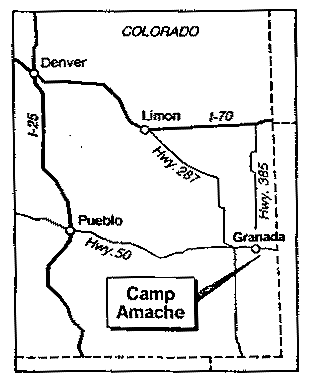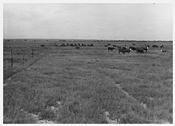Camp Amache is located in the Southeastern part of Colorado
near the town of Granada. Granada during the 1800's was known
as "The Gateway to Colorado." It was a popular stopover
along the Santa Fe Trail. The town was officially founded in
1873 and named in honor of a former Spanish kingdom by an unknown
person or persons. In the late 1800's Granada virtually became
a ghost town after losing a bid to become the county seat to
Lamar. It was not until 1942 with the building of Camp Amache
that Granada once again became a boom town.
The person most responsible for Granada's sudden turnaround
was U.S. Senator Edwin C. Johnson of Colorado. "Complying
with a request from the federal government the senator recommended
a tract of prairie land in Prowers County just south of Granada
as a potential sight for one of the relocation centers for Japanese-Americans
that were being hastily planned by military officials in Washington,
D.C." (Lurie
1990: 39). Senator Johnson like many other Coloradans was
against the building of an internment camp in Colorado. The site
near Granada met the main criteria set by the government: it
was well removed from major population centers. "When the
government announced that it had chosen the site in Prowers County
for the new internment camp most people in Colorado had never
heard of Granada" (Lurie
1990: 40).
The government bought over 10,000 acres of farm land from
private owners in the region around the town of Granada. The
land was south of the  Arkansas River and extended three miles west
and four miles east of Granada. Within this area was the deserted
town of Koen, which was the former headquarters of the American
Crystal Sugar Company. Another area of the land contained former
headquarters of the XY ranch and sixteen other farms (see
map). "Plans were made to use 640 acres of the land
on the lower edge of the entire holdings as the actual camp site" (Holsinger
1960: 37).
Arkansas River and extended three miles west
and four miles east of Granada. Within this area was the deserted
town of Koen, which was the former headquarters of the American
Crystal Sugar Company. Another area of the land contained former
headquarters of the XY ranch and sixteen other farms (see
map). "Plans were made to use 640 acres of the land
on the lower edge of the entire holdings as the actual camp site" (Holsinger
1960: 37).
Camp Amache officially opened on August 27, 1942. The WRA
officials referred to the camp as The Granada Project, but local
citizens and camp officials referred to the internment camp as
Camp Amache or Amache. Amache was named after an Indian princess
who was the daughter of Cheyenne Indian Chief One Eye. She played
a fascinating role in Colorado history. With the permission of
her father she courted and married John Wesley Prowers, a southern
Colorado cattleman credited with bringing the first Hereford
breeds into the territory. In 1864 Chief One Eye negotiated a
truce between the Cheyenne and Arapaho and the U.S. government.
According to the truce the Cheyenne were guaranteed a safe camping
area for the winter at their reservation along Sand Creek.
On the morning of November 28 soldiers from the Colorado
First Volunteer Calvary rode onto the ranch and held both the
Prowers as well as Amache hostage. At the camp along Sand Creek,
Colonel John Chivington ordered his regiment to attack the Indians.
The raid became known as the Sand Creek massacre. The massacre
claimed the lives of 150 Cheyenne and Arapaho. Among the dead
was Chief One Eye.
On several occasions at Camp Amache evacuees of the camp
claimed to have seen a ghost floating around the grounds at night.
Evacuees swore that they had seen "a strange, luminous figure
emerge from the shower room and embark upon a stroll of the premises.
Some describe [the ghost] as being attired in an Indian costume,
the whole body glowing with a faint, greenish light" (Lurie
1990: 43).
![Construction]()
Construction

Return to Amache

Arkansas River and extended three miles west and four miles east of Granada. Within this area was the deserted town of Koen, which was the former headquarters of the American Crystal Sugar Company. Another area of the land contained former headquarters of the XY ranch and sixteen other farms (see map). "Plans were made to use 640 acres of the land on the lower edge of the entire holdings as the actual camp site" (Holsinger 1960: 37).
